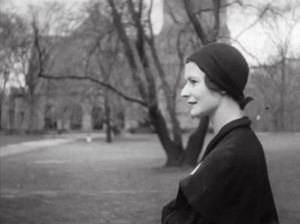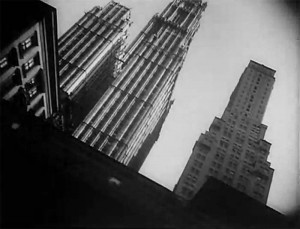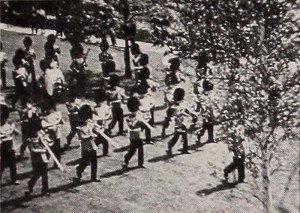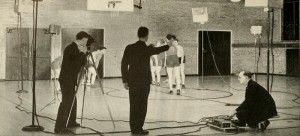
"She Goes to Vassar is a one-reel film that provides an overview of college life from the perspective of a new freshman student. From her arrival on campus, to settling into her new dorm and meeting her professors and classmates, the film depicts many facets of the college experience. Perhaps most striking about the film from today’s perspective are the shots of the academic environment, as the young women attend lectures and labs instructed by their professors, many of whom are also women. Though it was ultimately used primarily as a fundraising tool by the college’s alumni association, the film nevertheless provides a valuable glimpse of this women’s college through the eyes of a recent graduate." Women Film Pioneers Project

“The hard-edged graphics of 'Skyscraper Symphony' stand in contrast to other New York 'scenics' produced during the 1920s. Composed of skewed perspectives, Robert Florey’s camera looks straight up the domineering concrete behemoths. And it is hard to determine if the film mimics symphonic form as the title suggests or whether it advances a new methodology in musical-visual shot progression that reflects the alien structures depicted.” —Bruce Posner via Light Cone

"In Streets of Peace, Lewis B. Sebring, jr., presents a manifold accomplishment in film. Here is a record of the New York World's Fair 1939, but a record which, because of its selectivity, gives the impression of completeness in setting forth a single theme, although the material is both voluminous and varied. Here, also, is an interpretation of the epic idea behind the foreign participation in this great American exposition, the vision of peace, which has since been so rudely interrupted. Mr. Sebring takes his camera through the streets of peace, literally, and we see one after another of the foreign buildings and exhibits at the Fair; we also look at the different national celebrations in the Court of Peace. The visit of the King and Queen of England is recorded in considerable detail. After a scene of children of many lands uniting in a gathering in the Children's World, we find the pointed query as to what these youngsters will make of the "world of tomorrow," and the picture closes with distinguished shots of the United States Building, with its flag and the word "Peace," which appears on its façade. Mr. Sebring's titling is admirable, both in wording and in execution. His Kodachrome exposures have less good moments, but his camera handling is otherwise pleasing. Here is a workmanlike and finished recording of a great international event." Movie Makers, Dec. 1939, 635-636.
"Symphony Of The Village: Bert Seckendorf and his Cine Special camera have caught the colorful activities of Greenwich Village in one of the best color documentaries on this subject made to date. This famed New York spot, with its renowned artists, artisans and craftsmen, is revealed in all its gay, Bohemian color as the camera chronicles the activities of sidewalk artists, potters, ceramists, wood carvers and makers of novelty jewelry. The excellent titling knits together all the scenes and sequences into another top-notch picture for which this filmer has become famous in amateur circles." American Cinematographer, May. 1951, 190-2.
"Flaherty's New York film is a negotiation of modern urban culture (the city) by a filmmaker whose interests had primarily been of the exotic, the folk, the ancient cultures" (Tepperman 32).

"Y West Side, the joint production of Robert Coles, ACL, who directed the film, and Charles Coles and Edwin Schwarz, ACL, who photographed it, is a very successful publicity picture for the West Side Y. M. C. A. in New York City. Starting with the social and dormitory facilities of the "Y," the film carries the audience on a tour of gymnasiums, special exercise rooms, roof courts and pools. The abundance of athletic and exercise equipment is shown clearly in sequences of their use, and the carefully planned action throughout the picture maintains interest and continuity. This film is distinguished by excellent photography and by the successful solution of the innumerable problems in handling large scale interiors and group action. Ingenious adaptations of games and exercises were sometimes required in order to fit the scene to the camera field, determined by the exigencies of the space available. The talents of the three producers were so integrated as to make the enterprise an outstanding success." Movie Makers, Dec. 1935, 555.
"A lesson on FDR's Four Freedoms." ("More about an Amateur Cinema League of Nations.")
Total Pages: 3